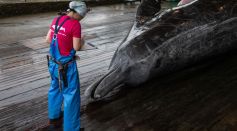Tags: Animals

Arctic Walrus Sleeping on Iceberg Wakes Up in Ireland, Proves Continental Drift Theory?
Cone Snails Attract Worms Only To Become a Meal

Over 30 Tasmanian Devil Roadkill Deaths in Woolnorth Road Found to Be Caused by Tumor Disease
Great Apes at San Diego Zoo Are First Non-Humans to Receive COVID-19 Vaccine
Which Animals Will Most Likely Cause The Next Big Pandemic?

Using Satellite Cameras, Scientists Counted Elephants From Space
Songbird Species Has "Babysitters" That Boost Offsprings of Older Birds
Is Wildlife Miserable During Winter?
Omega-3 Fat Helps Arctic Ground Squirrels Stay Warm During Hibernation

Study Reveals Sleep Evolved Ahead of Brain Evolution
First Case of Novel Coronavirus In A Non-Captive Animal, Detected on a Wild Mink

Scientists Found Unknown Beaked Whale Off Remote Island in Mexico

Louisville Zoo’s NeCee is the Latest Large Cat Confirmed to Have Coronavirus

Here’s How Sea Turtles Remember Their Natal Beach
Seal Populations in Europe Increased Due to COVID-19 Lockdowns

Hugging Pets, More Important Than Ever Because of the Pandemic

Scientists Predict Optimal Levels of Stress in Animals
Who's the Best Dad in the Animal Kingdom?

Masks Copied From Snorkeling Gear and Animal's Nasal Cavities, Effective as PPE

Can Your Cat or Dog Be Allergic to You? Here’s What Experts Say
Most Popular

Extreme Weather Science Reveals How Climate Change Patterns and Global Warming Transform Earth's Weather

What Causes Tornadoes and How They Form: Tornado Science Explained for Extreme Storms

Why Pandemics Keep Happening: Pandemic Cycle and the Rise of Emerging Diseases

How Planets Form: Planet Formation and Protoplanetary Disks in Solar System Creation




